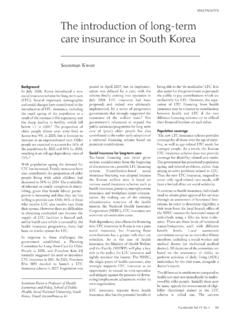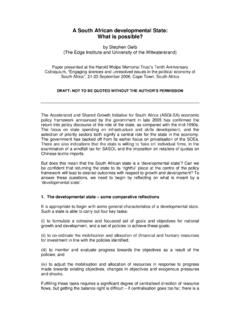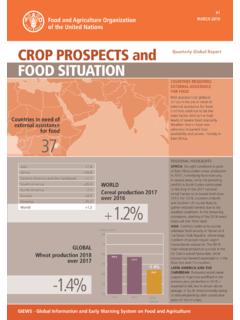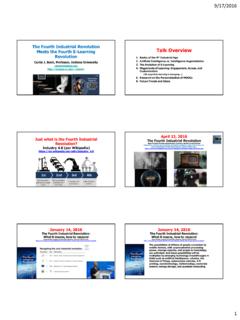Transcription of Human Resources Management Country Profiles KOREA
1 Last updated 06 December 2012 Human Resources Management Country Profiles KOREA Legal Framework Composition of Employment structureof central government 2008 Inside: KoreaOutside: OECD28 Background Legal Organisation of HR Senior Industrial GEF covers all employees: Yes GEF includes fixed-term contracts: Yes Private law applicable in public sector: No Data Employment under the GEF in the Korean civil service is governed by the National Civil Service Act (Revised 2004) and Contractual Civil Service Act, the latter of which allows up to five year fixed-term contracts. Employment under the GEF is split into two categories: career staff whose status/job security is guaranteed and are expected to work as civil servants until retirement; and non-career staff whose job security is not guaranteed.
2 Casual employment is permitted but falls under the private sector regulation of the Labour Standards Act. Regulation of private and public sector employment differs on several issues. Some categories of civil servants, such as educational officials, police officers, members of armed forces, and diplomats, have their own consolidated employment system. Part-time employment accounts for a very small fraction of overall employment under the GEF, partly because it has only been recently introduced, in February 2007. KOREA has a very young civil service compared to the OECD average. There was a particularly high proportion of 30-39 year olds, in 2008, compared to the OECD average of , and KOREA also has the lowest proportion of employees aged 50 or older out of all OECD countries, in 2008.
3 In addition, the civil service does not show a clear trend regarding age composition whereas the total labour force is clearly ageing, and at a higher rate than the OECD average. Finally, there is low representation of women in the civil service, both overall and within Management . Women account for of overall central government staff and of Management , significantly below the OECD averages of and , respectively. Staff have the right: Benefits, to which employees are entitled to, are: Firing rules provide: to unionise to strike Full funding of social security Partial funding of social security Some funding of pensions Different guarantees about job protection / dismissal Guarantees in favour of life-long employment Public sector No Data No Data No Data Yes No Data No Data Yes Private sector Yes Yes No Data No Data Yes Yes Yes Employment in central government under the main General Employment Framework (GEF): Central Human Resources Management body: Government centralisation (2008) Ministry of Public Administration and Security Data unavailable 2008: 154 317 Full-time equivalents (FTEs) Total employment in the general government sector as a percentage of labour force (2010).
4 Government production costs (2010) Type of recruitment system (2010) 0% 100% Career based Position based 0510152025303540200020052009200020052009 KoreaOECD AverageCentral GovernmentTotal Labour Force KoreaOECD33 Percentage of employees aged 50 years or older in central government and total labour force (2000, 2005 and 2009)* Employee compensationGoods & services usedFixed capital consumption Central government employment (2009) Total employment under GEF: 154 317 FTEs Part-time employment: 21 FTEs Part time is defined as those working 15-35 hours per week and was only introduced in February 2007. Gender in central government (2011) Female participation in central government workforce: Share of top and middle positions who are women: Data are for core ministries and agencies of central/federal governments Last updated 06 December 2012 Human Resources Management Country Profiles KOREA Public Sector Restructuring Organisation of HR Management Anticipated reforms' effect on employment level: No change Implemented changes in employment levels affecting more than 50% of ministries/agencies since 2000.
5 Change in retirement age Devolution of authority over other levels of government Contracting out Delegation to other public or semi-public organisations Reorganisation / restructuring KOREA is one of only five OECD countries to report that there are no anticipated changes to public sector employment levels. A range of measures have previously been implemented, including restructuring of government agencies, outsourcing and privatisation, but they are not expected to impact public employment in the future. The National Fiscal Management Plan is implementing a considerable consolidation plan; however, reductions in civil service employment levels or expenses do not feature as part of the strategy.
6 In the case of restructuring, the government is required to propose reallocation before dismissal, and voluntary departures with attractive allowances are regularly encouraged. General government sector employment (excluding public corporations) as a percentage of the labour force is the lowest of all OECD countries at just in 2010. In addition, compensation of government employees as a percentage of GDP, in 2010, is close to the OECD minimum of Strategic HR Management Existence of HRM accountability framework for managers: Yes, and HRM is fully linked to strategic objectives. HRM targets feed performance assessments: Yes Regular HRM assessment of ministries and departments: Yes Framework requires top & middle Management to plan and report on: General people Management Compliance with HR rules & targets for employment and pay Forward planning use: Yes, with framework design left to discretion of different organizations.
7 Forward-planning horizon: 4-5 years Key aspects explicitly considered in forward planning: New issues in policy delivery Civil service demographics Decentralisation of HR Management (2010) Central HRM unit: Ministry of Public Administration and Security Role: Responsible for defining HR policy Location: Ministry of Interior Responsibilities: Manage HRM at central/national level Provide leadership and guidance Design HR strategy Coordinate and supervise HR policy/strategy Provide advice on legal framework Design the pay system Transmit public service values Define and control the payroll Standardise recruitment and skills Profiles Define salary levels and benefits Provide training Promote diversity Manage retirement and pension plans Personnel, budget and pay delegation: The central HRM body sets and monitors pay systems.
8 Some latitude is given to ministries/agencies in managing budget allocation, bonuses and the number and types of posts. Classification, recruitment and dismissal delegation: The central HRM body sets and monitors the post classification system. Some latitude is given to ministries regarding recruitment decisions. Employee contract duration, career Management and dismissal decisions are delegated to ministries. Contract duration of posts is set by the unit/team. Employment conditions delegation: Some latitude is given to ministries regarding the flexibility of working conditions, performance assessment, the code of conduct and equal opportunity issues. Adjustments to working conditions are delegated to ministry and unit/team level. KOREA delegates HRM practices to line ministries to a slightly lesser extent than the average OECD Country .
9 The central HRM body shoulders a full range of responsibilities but allows ministries some latitude to apply principles regarding many issues. Delegation has led to a broadly comparable framework across the whole civil service. The utilisation of strategic HRM practices is significantly greater than the OECD average and lies in the upper region of the range. Key practices include an accountability framework that feeds performance assessment, regular HRM assessment of departments and a forward-planning system with a relatively long horizon. Managerial reporting and forward planning cover a small range of issues, however. 05101520253035 General government as a percentage of labour force (2010) Compensation of government employees as a percentage of GDP (2010) KoreaOECD32/33 OECD Range of delegation of HRM practices to line ministries in central government (2010) Utilisation of strategic HRM practices in central government(2010) KoreaOECD33/31 OECD Range Last updated 06 December 2012 Human Resources Management Country Profiles KOREA HR Management Practice RECRUITMENT: The recruitment system in use in KOREA is slightly more career based than the OECD average but is firmly in the middle of the range.
10 The open competitive recruitment process is usually managed by the central HRM unit through centrally conducted examinations, while a career-based recruitment system is managed by the central HRM unit and also other related agencies. The ratio of competitive recruitment was in 2010. There are hiring targets regarding gender, disabled persons and low income groups. If the proportion of one gender passing a recruitment examination is less than 30%, additional applicants of that gender will be recruited. In addition, there is a 1% quota for all new recruits to be from low income backgrounds and a 3% quota for disabled people. of recruitment system used in central government (2010)KoreaOECD33 OECD RangePositionCareer of the use of performance assessments in HR decisions in central government (2010)Extent of the use of performance-related pay in central government (2012)^KoreaOECD31/33 OECD Range PERFORMANCE: KOREA uses performance assessment to a slightly higher extent than the OECD average.

















